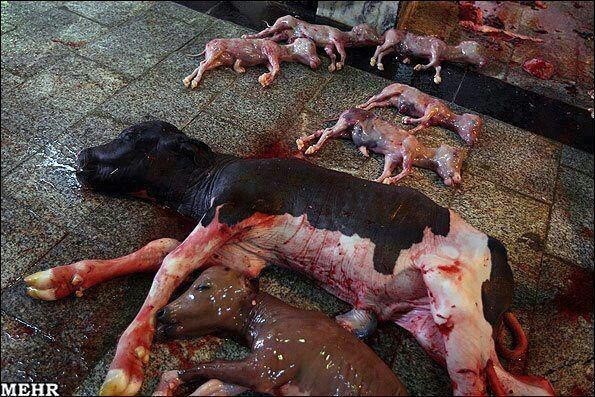Defined cell culture media (basal media) are the standard media for cultivating animal and human cells. However, the primary cells or cell lines are additionally “motivated” to divide, by means of a not entirely understood interaction between hormones and growth factors from foetal bovine serum (FBS), which is added to the basal medium. This serum introduces an undefined mixture of biologically active substances to a defined culture – a procedure that would normally be unjustifiable in scientific terms.
However, millions of laboratories worldwide use foetal bovine serum for growing their cells – and their numbers are increasing. This especially pleases those who produce and deliver the serum; due to the growing demand, the price has increase almost fivefold since 2008, which increasingly makes researchers financially dependent on suppliers of the serum. The fact that using animal serum from bovine foetuses with (mostly) human cells is not a physiological process was ignored for a long time.
After the latest much respected Nature survey published in May 2016, this claim must be reconsidered, because some two thirds of all scientific studies are not reproducible at all, more than 50 per cent even in the same laboratory (1).
Obtaining FBS involves great suffering for the animals. Scientists estimate that 10 per cent of all cows in slaughterhouses are pregnant (2). It is estimated that 800,000 litres of FBS are sold worldwide each year (3). Some cows give birth on the way to the slaughterhouse, but in most cases, the mother cows arrive still pregnant, where they are stunned by bolt gun and often hanging by one leg killed by exsanguination (4). The foetus asphyxiates in the dead mother’s body. 
Here 3.5 litres of FBS are still extracted by cardiac puncture.
Source: Occupy for Animals (http://www.occupyforanimals.net/fetal-bovine-serum-or-fetal-calf-serum.html)
For ages there exist Alternatives to the fetal falf sera. For nearly 20 Years, scientists develop serum-free media. But the work of responsible research had not been appreciated. In the field of regenerative medicine the use of fcs is not allowed because the developing tissues would uptake an amino acid which does not exist in humans. The new database will contribute to replacement of animals used for research and the reproducibility of in vitro methods. For scientific reasons the animal-free research should follow the regenerative medicine.
Launch Invitation FCS Database
When: 15 August 2017, 12 Uhr bis 13 Uhr
Where: David de Wied building, room 2.01 - Universiteitsweg 99, 3584 CG Utrecht, the Netherlands
Registrations till the 13th of August under: https://fd8.formdesk.com/universiteitutrecht/FCS-free-database
For more information:
https://www.animalfreeresearchuk.org/serum-free-media
(1) Bayer, M. (2016): Is there a Reproducibility Crisis? Nature 533: 452-454.
(2) Deutscher Bundestag Drucksache 18/1535 vom 26. Mai 2014. http://dipbt.bundestag.de/dip21/btd/18/015/1801535.pdf
(3) Gstraunthaler, G., Lindl, T. & van der Valk, J. (2014): A severe Case of Fraudulent Blending of Fetal Bovine Serum Strengthens the Case for Serum-free Cell and Tissue Culture Applications. ATLA 42: 207-209.
(4) Hilsenbeck, E. M. (2007): Untersuchungen zur Entblutezeit bei Rindern nach Bolzenschuß-betäubung. Dissertation an der tierärztlichen Fakultät der Ludwig-Maximilians-Universität München. http://webcache.googleusercontent.com
Außerdem:
http://www.invitrojobs.com/index.php/de/forschung-methoden/arbeitsgruppe-im-portrait/item/1763-arbeitsgruppe-im-portrait-molekulare-physiologie-der-niere-der-medizinischen-universitaet-innsbruck
http://www.invitrojobs.com/index.php/de/forschung-methoden/arbeitsgruppe-im-portrait/item/2142-arbeitsgruppe-im-portrait-institut-fuer-stammzellforschung-und-regenerative-medizin-duesseldorf
Friday, 07 July 2017 11:57
Invitation to the launch of a Serum free Database Featured
Animal-Free Research UK (formerly Dr. Hadwen Trust), the largest British foundation for animal-free medical research has invested 3.2 million pounds in research during the past 5 years and compiled a database of commercially available serum-free media, available as a resource for researchers around the world looking for suitable media. Goal is to replace the fetal calf sera as quick as possible. Together with the 3R-Centre Utrecht Life Sciences the database will be launched with a short opening ceremony in Utrecht.




 Dr. rer. nat.
Dr. rer. nat. Menschen für Tierrechte - Tierversuchsgegner Rheinland-Pfalz e.V.
Menschen für Tierrechte - Tierversuchsgegner Rheinland-Pfalz e.V.